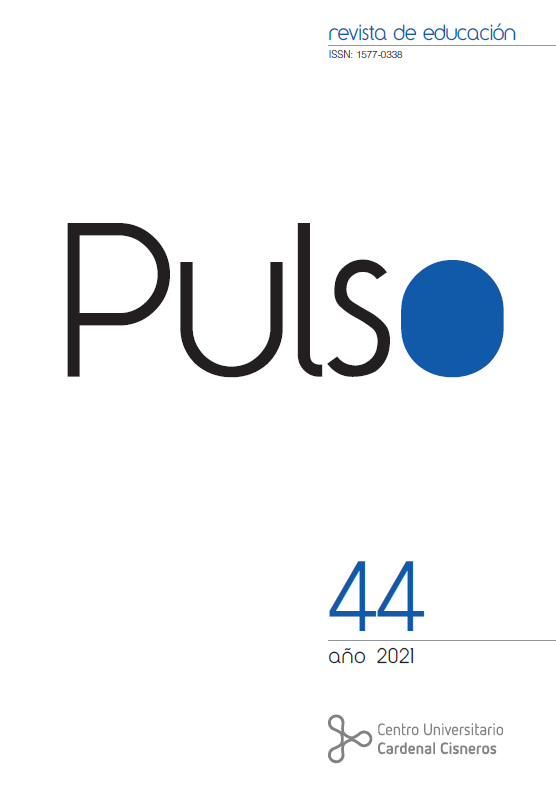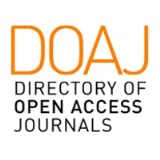Enseñanza de la Historia durante Covid-19
DOI:
https://doi.org/10.58265/pulso.4655Palabras clave:
Aprendizaje asistido por móviles, Habilidades del siglo XXI, Aula invertidaResumen
Este informe resume la experiencia de un Liceo Italiano, más exactamente un primer curso, durante la pandemia, razón por la que los alumnos participaron en las clases turnándose semanalmente, o todos en confinamiento. Para promover conocimientos concretos y las habilidades del siglo XXI, desde las de Aprendizaje, en un entorno participativo, se adoptó la clase invertida, en la cual los alumnos tuvieron que: revisar fuentes, también en 3D; escribir un documento en línea (Word), respondiendo a preguntas de
compañeros; elaborar una narrativa digital del tema para exponerla oralmente, colaborando a través de redes sociales (WhatsApp) y herramientas colaborativas en línea; finalmente, responder a un cuestionario (Quizziz). Los resultados se refieren a: el compromiso de la clase, para la comprensión y los conocimientos esenciales de los estudiantes; inclusión de debilidades, por su papel activo cooperando; inclusión de los móviles como herramienta democrática; ubicuidad del aprendizaje, que minimiza la distancia entre la educación en línea y presencial; especialmente, fomentar el alcance de las competencias del siglo XXI, principalmente el aprendizaje-para-aprender. Por eso, lo que enseñó el confinamiento siempre será importante didácticamente.
Descargas
Citas
Al-Azawi, R., AlFuliti, F., & AlBalushi, M. (2016). Educational Gamification Vs. Game Based Learning: Comparative Study. International Journal of Innovation, Management and Technology, 7(4), –136. https://doi.org/10.18178/ijimt.2016.7.4.659
Ardan, M., Rahman, F. F., & Geroda, G. B. (2020). The influence of physical distance to student anxiety on COVID-19, Indonesia. Journal of Critical Reviews, 7(17), 1126–1132. https://doi.org/10.31838/jcr.07.17.141
Baloran, E. T. (2020). Knowledge, Attitudes, Anxiety, and Coping Strategies of Students during COVID-19 Pandemic. Journal of Loss and Trauma, 25(8), 635–642. https://doi.org/10.1080/15325024.2020.1769300
Buzzi, C., Tucci, M., Ciprandi, R., Brambilla, I., Caimmi, S., Ciprandi, G., & Marseglia, G. L. (2020). The psycho-social effects of COVID-19 on Italian adolescents’ attitudes and behaviors. Italian Journal of Pediatrics, 46(1), 4–10. https://doi.org/10.1186/s13052-020-00833-4
Cellini, N., Di Giorgio, E., Mioni, G., & Di Riso, D. (2021). Sleep and Psychological Difficulties in Italian School-Age Children During COVID-19 Lockdown. Journal of Pediatric Psychology, 46(2), –167. https://doi.org/10.1093/jpepsy/jsab003
Chen, Y., Carger, C. L., & Smith, T. J. (2017). Mobile-assisted narrative writing practice for young english language learners from a funds of knowledge approach. Language Learning and Technology, (1), 28–41.
Cinganotto, L., & Cuccurullo, D. (2016). CLIL e CALL nell’expertise del docente: un’esperienza di formazione internazionale CLIL and CALL for a teacher’s expertise: an international training experience, 16, 319–336.
Coyle, D. (2015). Strengthening integrated learning: Towards a new era for pluriliteracies and intercultural learning. Latin American Journal of Content and Language Integrated Learning, 8(2), –103. https://doi.org/10.5294/laclil.2015.8.2.2
Faith, Y., Kumalija, E. J., & Sun, Y. (2019). Mobile Learning Based Gamification In a History Learning Context. In I. A. et al. Sanchez (Ed.), Proceedings - 14th International Conference Mobile Learning. Lisbon, 14-16 April 2018 (pp. 143–147). Lisbon: Curran Associates, Inc.
Gee, J. P. (2014). Reading, Language Development, Video Games, and Learning in the 21st Century. In Collected essays on learning and assessment in the digital world. Champaign, IL: Common Ground. Retrieved from http://vimeo.com/15732568
Giovannella, C., Passarelli, M., & Persico, D. (2020). The Effects of the Covid-19 Pandemic on Italian Learning Ecosystems: the School Teachers’ Perspective at the steady state. Interaction Design and Architecture(S), 45, 264–286.
Gutiérrez Almarza, G., Durán Martínez, R., & Beltrán Llavador, F. (2012). CLIL in teacher training: A Nottingham Trent University and University of Salamanca experience. Encuentro, 21, 48–62.
Jenkins, H., Clinton, K., Purushotma, R., Robison, A. J., & Weigel, M. (2006). Confronting the Challenges of Participatory Culture: Media Education for the 21st Century. Chicago, Illinois: MacArthur Foundation. https://doi.org/10.1016/b978-0-12-801867-5.00008-2
Jo, I. (2016). Future Teachers ’ Dispositions Toward Teaching With Geospatial Technologies. Contemporary Issues in Technology and Teacher Education, 16(3), 310–327.
Koehler, M. J., & Mishra, P. (2006). Technological Pedagogical Content Knowledge: A Framework for Teacher Knowledge. Teachers College Record, 108(6), 1017–1054.
Krutka, D. G., & Carpenter, J. P. (2016). Participatory Learning Through Social Media: How and Why Social Studies Educators Use Twitter. Contemporary Issues in Technology and Teacher Education, 16(1), 38–59.
Kysela, J., & Štorková, P. (2015). Using Augmented Reality as a Medium for Teaching History and Tourism. Procedia - Social and Behavioral Sciences, 174, 926–931. https://doi.org/10.1016/j.sbspro.2015.01.713
Liu, C. K. W. (2019). A holistic approach to flipped classroom: A conceptual framework using e-platform. International Journal of Engineering Business Management, 11, 1–9. https://doi.org/10.1177/1847979019855205
Lo, C. K. (2017). Toward a Flipped Classroom Instructional Model for History education: A Call for Research. International Journal of Culture and History (EJournal), 3(1), 36–43. https://doi.org/10.18178/ijch.2017.3.1.075
Mahmood, S. (2021). Instructional Strategies for Online Teaching in COVID-19 Pandemic. Human Behavior and Emerging Technologies, 3(1), 199–203. https://doi.org/10.1002/hbe2.218
Maloy, R., Kommers, S., & Malinowski, A. (2017). 3D Modeling and Printing in History/Social Studies Classrooms: Initial Lessons and Insights. Contemporary Issues in Technology and Teacher Education, 17(2), 229–249. Retrieved from https://citejournal.s3.amazonaws.com/wp-content/uploads/v17i2socialstudies1.pdf
Mason, C., Berson, M., Diem, R., Hicks, D., Tech, V., Lee, J., & Dralle, T. (2000). Guidelines for Using Technology to Prepare Social Studies Teachers. Contemporary Issues in Technology and Teacher Education, 1(1), 107–116.
Miangah, T. M. (2012). Mobile-Assisted Language Learning. International Journal of Distributed and Parallel Systems, 3(1), 309–319. https://doi.org/10.5121/ijdps.2012.3126
Morton, T. (2020). Cognitive Discourse Functions: A Bridge between Content, Literacy and Language for Teaching and Assessment in CLIL. CLIL. Journal of Innovation and Research in Plurilingual and Pluricultural Education, 3(1), 7. https://doi.org/10.5565/rev/clil.33
Neville, D. O., & Shelton, B. E. (2010). Literary and historical 3ddigital game-based learning: Design guidelines. Simulation and Gaming, 41(4), 607–629. https://doi.org/10.1177/1046878108330312
Ozdamli, F., & Asiksoy, G. (2016). NI-Flipped Classroom Approach-Contemporaneos. World Journal on Educational Technology, 8(2), 98–105.
Parsons, D. (2014). A mobile learning overview by timeline and mind map. International Journal of Mobile and Blended Learning, 6(4), 1–21. https://doi.org/10.4018/ijmbl.2014100101
Pezzot, E. (2016). Il digital storytelling per un’educazione linguistica interculturale. EL.LE Educazione Linguistica. Language Education, 5(2), 213–254. https://doi.org/10.14277/2280-6792/ELLE-5-2-2
Porcedda, M. E. (2021). Educational prospects of Techno-CLIL strategies and implementation in the subject of History for the last triennium of Secondary schools. Universitas Tarraconensis. Revista de Ciències de l’Educació, 1(3), 79. https://doi.org/10.17345/ute.2020.3.3036
Pragholapati, A. (2020). Covid-19 Impact on Students, 1–6. https://doi.org/10.35542/osf.io/895ed
Redecker, C. (2009). Review of learning 2.0 practices: study on the impact of Web 2.0 innovations on education and training in Europe. JRC Scientific and Technical Reports. Luxembourg: JRC European Commission.
Rodrígues, P., & Bidarra, J. (2014). Transmedia storytelling and the creation of a converging space of educational practices. International Journal of Emerging Technologies in Learning, 9(6), –48. https://doi.org/10.3991/ijet.v9i6.4134
Siti, W. A. L., Matzin, R., Jawawi, R., Mahadi, M. A., Jaidin, J. H., Mundia, L., & Shahrill, M. (2017). Implementing the Flipped Classroom Model in the Teaching of History. Journal of Education and Learning (EduLearn), 11(4), 374–381. https://doi.org/10.11591/edulearn.v11i4.6390
Smirni, P., Lavanco, G., & Smirni, D. (2020). Anxiety in Older Adolescents at the Time of COVID-19. Journal of Clinical Medicine, 9(10), 3064. https://doi.org/10.3390/jcm9103064
Wan, G., & Gut, D. M. (2011). Twenty-first century students need 21st century skills. Bringing schools into the 21st century (Vol. 13). Retrieved from http://scholar.google.com/scholar?hl=en&btnG=Search&q=intitle:No+Title#0%5Cnhttp://link.springer.com/chapter/1007/978-94-007-0268-4_3
Warnich, P., & Gordon, C. (2015). The integration of cell phone technology and poll everywhere as teaching and learning tools into the school History classroom. Yesterday and Today, (13), 40–66.
Descargas
Publicado
Cómo citar
Número
Sección
Licencia
Derechos de autor 2022 Pulso. Revista de educación

Esta obra está bajo una licencia internacional Creative Commons Reconocimiento-NoComercial-SinObraDerivada 3.0.
Esta revista proporciona un acceso abierto inmediato a su contenido, basado en el principio de que ofrecer al público un acceso libre a las investigaciones ayuda a un mayor intercambio global de conocimiento.
Las obras se publican en la edición electrónica de la revista bajo una licencia Creative Commons Reconocimiento-NoComercial-SinObraDerivada 4.0
Se permite y se anima a los autores a difundir electrónicamente la versión post-print (versión evaluada y aceptada para su publicación) de sus obras antes de su publicación, ya que favorece su circulación y difusión más temprana y con ello un posible aumento en su citación y alcance entre la comunidad académica.














